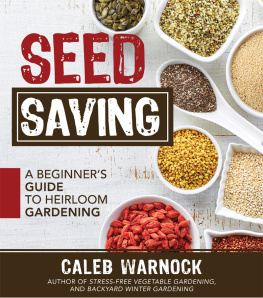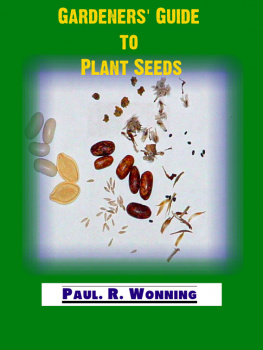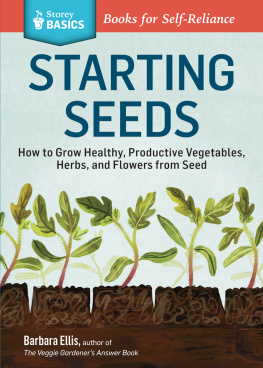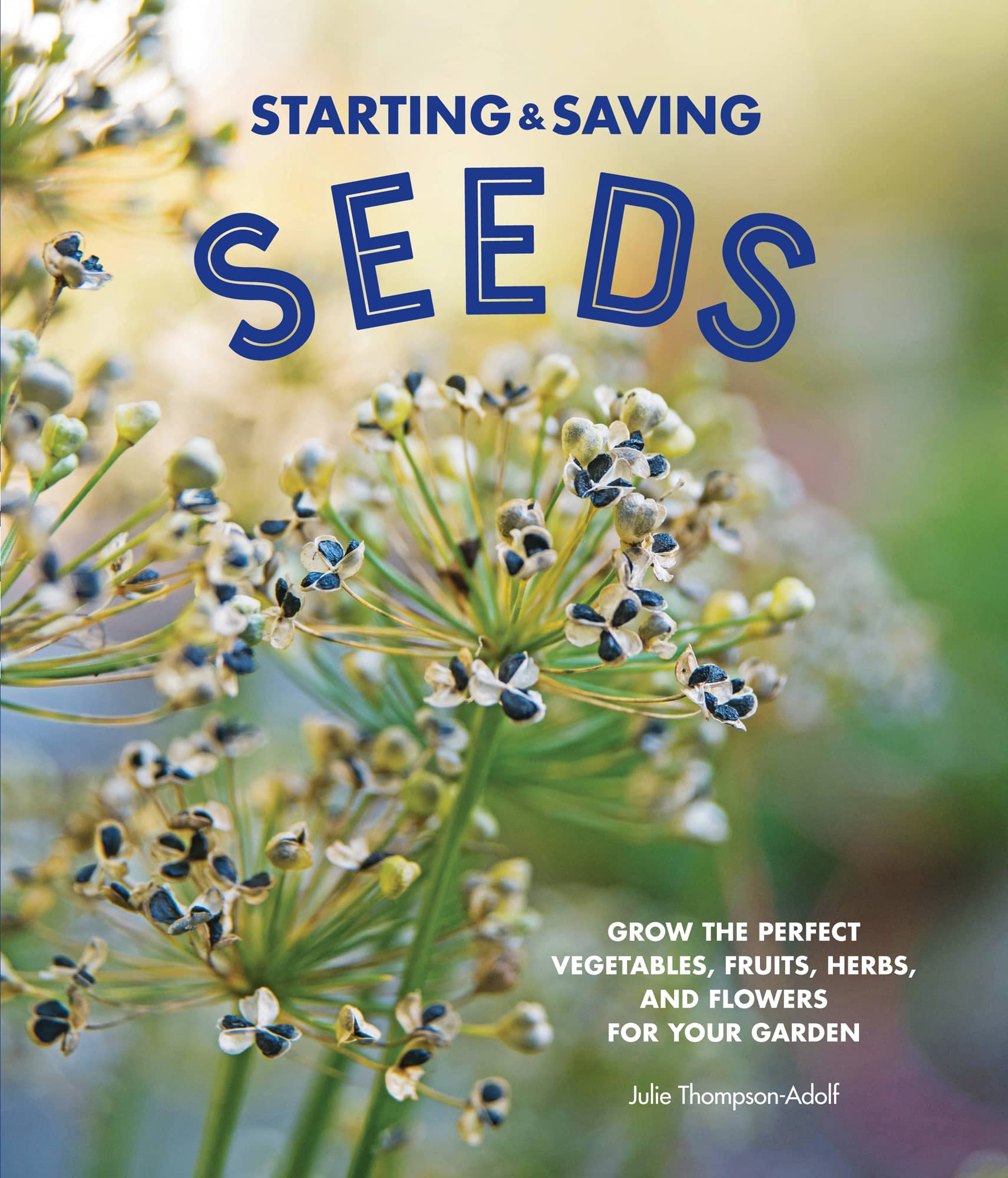STARTING & SAVING
SEEDS
GROW THE PERFECT
VEGETABLES, FRUITS, HERBS,
AND FLOWERS
FOR YOUR GARDEN
Julie Thompson-Adolf

Introduction
When I was in kindergarten, I planted a bean. I imagine at some point as a child you did too. I remember sticking a bean seed in a Dixie cup partially filled with dirt, watering it until the soil became muddy, watching it sprout, then proudly presenting it to my mom and dad. After a week or two of a five-year-olds tough loveDrown it in water! Carry it everywhere! Tuck it in bed!the plant shriveled and died. I hope your little plant enjoyed a happier life than mine.
Often our first, unfortunate experiences growing seeds make us believe we possess black thumbs. I promise youits not true. That poor, ill-fated bean simply fell victim to a kindergarteners lack of knowledge about what comes next: how does that cute little sprout turn into a healthy plant that provides pretty blooms and, ultimately, food for a family? My kindergarten teacher, while an incredibly sweet and patient woman, skipped the follow-up lesson.
While some books about seed starting and saving can be a tad technical, thats not the background for most home gardeners. Instead, I believe in an illustrated, learning-by-doing approach. Here youll find step-by-step instructions for everything from selecting great seeds to creating your own seed-starting mix to harvesting seeds for next years garden.
I love a good story as much as I adore seeds. Yes, we need to know some science to grow and save seeds properly, but the beauty of heirloom seeds lies not only in the delicious meals we create from our harvests, but also in the history and heritage behind those seeds origins. Did you know that in the past two hundred years, weve lost 94 percent of the fruit and vegetables that we once grew? Ill introduce you to some of these interesting plant varieties along the way, show how you can grow them in your garden, and help you perpetuate these varieties by saving their seeds.
That said, Im also the kind of gardener who likes quick recommendations when Im in a hurry. Lets face it: who among us spends all day, every day, gardening? We want success from our gardens while in the throes of chasing kids, working jobs, and even when writing books. Because daily life interferes with gardening time, Ive included highlighted tips throughout the book, such as Top 10 Tomatoes for Cool, Short-Season Climates or Top 10 Prettiest, Tastiest Lettuces.
Think of me as your new friend or the neighbor next door who loves to garden. Together well banish any fears of failure and create a beautiful, healthy, delicious, self-sufficient gardenfrom seed.
Lets get started!
I
HOW TO START, GROW, AND SAVE SEEDS
CHAPTER 1
Getting Started
In the heart of winter, the seed catalogs arrive. Is there anything better for a gardeners mood than dreaming of beds filled with fruit, vegetables, and blooms? While its lovely to look through photos and dream of spring, the best part of seed starting is that as the snow still swirls outside your windows, your hands will be buried in seed-starting mix. Sowing seeds and nurturing green babies that will fill your garden is rewarding from the start.

Why Start Seeds?
Seed starting and saving no longer exclusively pertain to farmers and master gardeners. On the contrary, most home gardeners grow something from seed. Whether its a handful of zinnia seeds sprinkled in a flower bed or a formal potager filled with home-grown flowers, fruits, vegetables, and herbs, seed starting and saving have gained mainstream status among home gardeners in the past decade. If youre like me, theres a tower of seed catalogs on your desk, tempting you with their gorgeous photography and lovely seed stories. Gardeners grow seeds for a variety of reasons. Lets run through a few of them.
Greater Variety
When I started growing plants to sell at our farmers market, my husband, Peter, was perplexed. Why do you need to grow sixty-four varieties of tomatoes? he asked. Tomatoes are just round and red. Oh, Peter. My poor husband had no idea that two years later, Id grow 168 varieties of tomatoes in one season.
Red, yellow, black, green, striped, orange, speckled, white... why limit yourself to round, red tomatoes? The big box stores and nurseries typically offer only the most basic tomato varieties, and those are mostly hybrid plants. The same is true for cucumbers, beans, peppers, wellreally anything you can grow in the garden. Growing from seed opens up a world of colors, flavors, textures, and beauty for your garden. (Its funny. Ive realized as Ive been harvesting tomatoes this summer, theres not one round, red tomato among the vines. Huh.)
Seeds provide an endless supply of plant varieties. Why settle for red tomatoes when you can grow an entire rainbow of them?
PASSION FOR PURPLE FOOD? GROW THESE UNUSUAL SEEDS
Purple Podded Pole Bean
Cherokee Purple Tomato
Purple Beauty Bell Pepper
Black Beauty Eggplant
Violetta Italia Cauliflower
Purple Dragon Carrot
Early Purple Sprouting Broccoli
Tte Noire Cabbage
Early Purple Vienna Kohlrabi
Blue Podded Blauwschokkers Peas
Better Control
When you grow plants from seeds, youre in greater control of when to start your crops of food and flowers. Yes, youll need a bit of planning and some extra resources to outsmart Mother Nature and get a jump on the growing season. Still, its worth it to have healthy, mature transplants ready to plant after the danger of frost is past. And if you own a greenhouse, growing from seed allows you to grow delicious food and lovely blooms all year long. Even if you dont have the budget for a greenhouse, you can still benefit from plants grown from seed year-round, with a little creativity.
Likewise, youre in better control of the health of your plants. Weve all seen transplants at certain stores that look less than well-tended. Besides the droopy leaves from lack of water or the obvious heat stress, are you confident that those organic vegetable plants are truly organic? Did a part-time worker accidentally dose them with pesticide? If youre growing flowers for pollinators, the last thing you want is a plant grown with neonicotinoidsinsecticides absorbed by plants, which can then transfer to its pollen and nectar. As you can imagine, if youre growing flowers to attract pollinators, you dont want to offer them a toxic buffet. By growing your own plants from seed, you know that the plants going into your gardenand into your dinnerare healthy.















